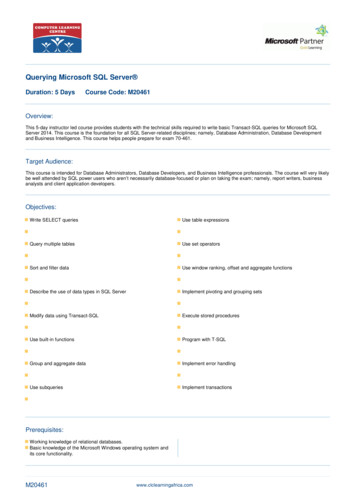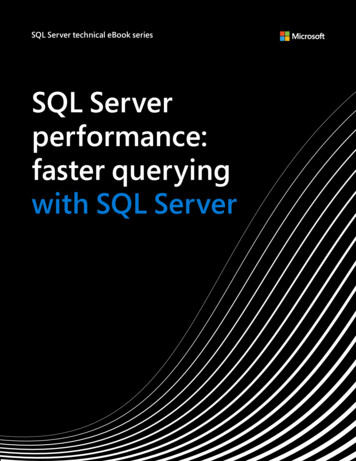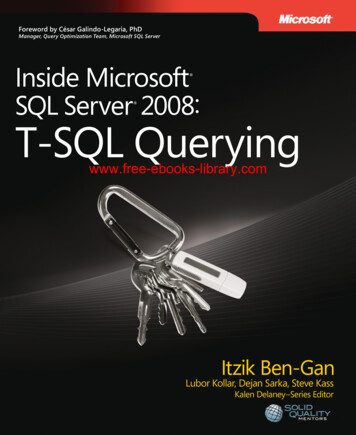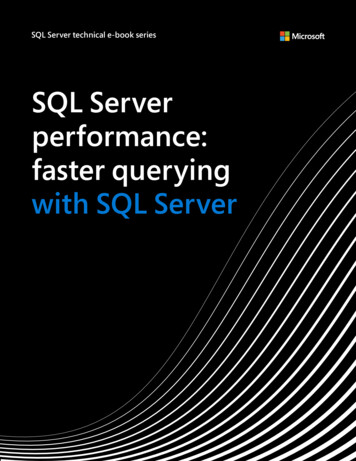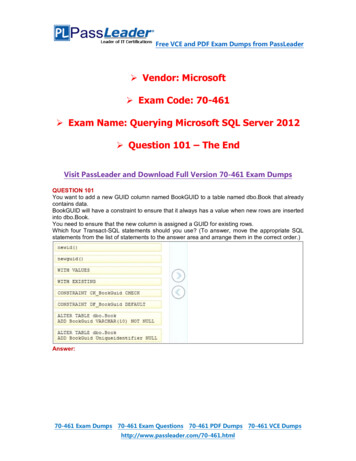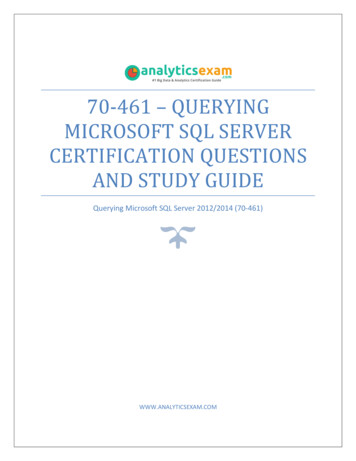
Transcription
70-461 – QUERYINGMICROSOFT SQL SERVERCERTIFICATION QUESTIONSAND STUDY GUIDEQuerying Microsoft SQL Server 2012/2014 (70-461)WWW.ANALYTICSEXAM.COM
[EXAMCODE] – [EXAMNAME] CERTIFICATION QUESTIONS AND STUDY GUIDEContentsQuerying Microsoft SQL Server Details. 2Querying Microsoft SQL Server Syllabus for 70-461 Exam (Study Aid) . 3Querying Microsoft SQL Server (70-461) Sample Questions . 5www.analyticsexam.comPage 1
[EXAMCODE] – [EXAMNAME] CERTIFICATION QUESTIONS AND STUDY GUIDEQuerying Microsoft SQL Server CertificationDetailsExam NameExam CodeDurationPassing PercentageNegative MarkingPartial CreditQuerying Microsoft SQL Server 2012/201470-461120 Minutes700 out of 1000No Negative MarkingNo Partial creditReference BookSchedule Your examSample QuestionsRecommended PracticetoolTraining Kit (Exam 70-461): Querying Microsoft SQL Server 2012www.analyticsexam.comQuerying Microsoft SQL Server 2012/2014Querying Microsoft SQL Server Certification Sample QuestionQuerying Microsoft SQL Server Certification Practice ExamPage 2
[EXAMCODE] – [EXAMNAME] CERTIFICATION QUESTIONS AND STUDY GUIDEQuerying Microsoft SQL Server CertificationSyllabus for 70-461 (Study Aid)Create database objects (20–25%)1. Create and alter tables using T-SQL syntax (simple statements) Create tables without using the built in tools; ALTER; DROP; ALTER COLUMN;CREATE2. Create and alter views (simple statements) Create indexed views; create views without using the built in tools; CREATE,ALTER, DROP3. Design views Ensure code non regression by keeping consistent signature for procedure,views and function (interfaces); security implications4. Create and modify constraints (simple statements) Create constraints on tables; define constraints; unique constraints; defaultconstraints; primary and foreign key constraints5. Create and alter DML triggers Inserted and deleted tables; nested triggers; types of triggers; updatefunctions; handle multiple rows in a session; performance implications oftriggersWork with data (25–30%)1. Query data by using SELECT statements Use the ranking function to select top(X) rows for multiple categories in asingle query; write and perform queries efficiently using the new (SQL2005/8- ) code items such as synonyms, and joins (except, intersect);implement logic which uses dynamic SQL and system metadata; writeefficient, technically complex SQL queries, including all types of joins versusthe use of derived tables; determine what code may or may not executebased on the tables provided; given a table with constraints, determinewhich statement set would load a table; use and understand different dataaccess technologies; case versus isnull versus coalescewww.analyticsexam.comPage 3
[EXAMCODE] – [EXAMNAME] CERTIFICATION QUESTIONS AND STUDY GUIDE2. Implement sub-queries Identify problematic elements in query plans; pivot and unpivot; applyoperator; cte statement; with statement3. Implement data types Use appropriate data; understand the uses and limitations of each data type;impact of GUID (newid, newsequentialid) on database performance, when touse what data type for columns4. Implement aggregate queries New analytic functions; grouping sets; spatial aggregates; apply rankingfunctions5. Query and manage XML data Understand XML datatypes and their schemas and interop w/, limitations andrestrictions; implement XML schemas and handling of XML data; XML data:how to handle it in SQL Server and when and when not to use it, includingXML namespaces; import and export XML; XML indexingModify data (20–25%)1. Create and alter stored procedures (simple statements) Write a stored procedure to meet a given set of requirements; branchinglogic; create stored procedures and other programmatic objects; techniquesfor developing stored procedures; different types of storeproc result; createstored procedure for data access layer; program stored procedures, triggers,functions with T-SQL2. Modify data by using INSERT, UPDATE, and DELETE statements Given a set of code with defaults, constraints, and triggers, determine theoutput of a set of DDL; know which SQL statements are best to solvecommon requirements; use output statement3. Combine datasets Difference between UNION and UNION all; case versus isnull versuscoalesce; modify data by using MERGE statements4. Work with functions Understand deterministic, non-deterministic functions; scalar and tablevalues; apply built-in scalar functions; create and alter user-defined functions(UDFs)www.analyticsexam.comPage 4
[EXAMCODE] – [EXAMNAME] CERTIFICATION QUESTIONS AND STUDY GUIDETroubleshoot and optimize (25–30%)1. Optimize queries Understand statistics; read query plans; plan guides; DMVs; hints; statisticsIO; dynamic vs. parameterized queries; describe the different join types(HASH, MERGE, LOOP) and describe the scenarios they would be used in2. Manage transactions Mark a transaction; understand begin tran, commit, and rollback; implicit vsexplicit transactions; isolation levels; scope and type of locks; trancount3. Evaluate the use of row-based operations vs. set-based operations When to use cursors; impact of scalar UDFs; combine multiple DMLoperations4. Implement error handling Implement try/catch/throw; use set based rather than row based logic;transaction managementwww.analyticsexam.comPage 5
[EXAMCODE] – [EXAMNAME] CERTIFICATION QUESTIONS AND STUDY GUIDEQuerying Microsoft SQL Server Exam (70461) Sample Questions Below are the 10 sample questions which will help you be familiar with QueryingMicrosoft SQL Server 2012/2014 (70-461) exam style and Structure. These questions are just for demonstration purpose, there are many scenario basedquestion are included in Premium Querying Microsoft SQL Server Practice Exam Access to all 230 questions is available only through premium practice exam availableto members at www.analyticsexam .comQ 1: Your database contains two tables named DomesticSalesOrders andInternationalSalesOrders. Both tables contain more than 100 million rows. Eachtable has a Primary Key column named SalesOrderId. The data in the two tables isdistinct from one another.Business users want a report that includes aggregate information about the totalnumber of global sales and total sales amounts. You need to ensure that yourquery executes in the minimum possible time. Which query should you use?Options:A. SELECT COUNT(*) AS NumberOfSales, SUM(SalesAmount) AS TotalSalesAmountFROM DomesticSalesOrders UNION SELECT COUNT(*) AS NumberOfSales,SUM(SalesAmount) AS TotalSalesAmount FROM InternationalSalesOrdersB. SELECT COUNT(*) AS NumberOfSales, SUM(SalesAmount) AS TotalSalesAmountFROM ( SELECT SalesOrderId, SalesAmount FROM DomesticSalesOrders UNION ALLSELECT SalesOrderId, SalesAmount FROM InternationalSalesOrders ) AS pC. SELECT COUNT(*) AS NumberOfSales, SUM(SalesAmount) AS TotalSalesAmountFROM ( SELECT SalesOrderId, SalesAmount FROM DomesticSalesOrders UNIONSELECT SalesOrderId, SalesAmount FROM InternationalSalesOrders ) AS pD. SELECT COUNT(*) AS NumberOfSales, SUM(SalesAmount) AS TotalSalesAmountFROM DomesticSalesOrders UNION ALL SELECT COUNT(*) AS NumberOfSales,SUM(SalesAmount) AS TotalSalesAmount FROM InternationalSalesOrdersQ 2: Your database contains tables named Products and ProductsPriceLog. TheProducts table contains columns named ProductCode and Price. TheProductsPriceLog table contains columns named ProductCode, OldPrice, andNewPrice.The ProductsPriceLog table stores the previous price in the OldPrice column andthe new price in the NewPrice column.You need to increase the values in the Price column of all products in the Productstable by 5 percent. You also need to log the changes to the ProductsPriceLog table.Which Transact-SQL query should you use?www.analyticsexam.comPage 6
[EXAMCODE] – [EXAMNAME] CERTIFICATION QUESTIONS AND STUDY GUIDEOptions:A. DATE Products SET Price Price * 1.05OUTPUT inserted.ProductCode, deleted.Price, inserted.Price INTOProductsPriceLog(ProductCode, OldPrice, NewPrice)B. UPDATE Products SET Price Price * 1.05OUTPUT inserted.ProductCode, inserted.Price, deleted.Price INTOProductsPriceLog(ProductCode, OldPrice, NewPrice)C. UPDATE Products SET Price Price * 1.05OUTPUT inserted.ProductCode, deleted.Price, inserted.Price * 1.05 INTOProductsPriceLog(ProductCode, OldPrice, NewPrice)D. UPDATE Products SET Price Price * 1.05INSERT INTO ProductsPriceLog(ProductCode, OldPrice, NewPrice) SELECTProductCode, Price, Price * 1.05 FROM ProductsQ 3: Your database contains a table named SalesOrders. The table includes aDATETIME column named OrderTime that stores the date and time each order isplaced. There is a nonclustered index on the OrderTime column.The business team wants a report that displays the total number of orders placedon the current day. You need to write a query that will return the correct results inthe most efficient manner. Which Transact-SQL query should you use?Options:A. SELECT COUNT(*) FROM SalesOrders WHERE OrderTime GETDATE()B. SELECT COUNT(*) FROM SalesOrders WHERE CONVERT(VARCHAR, OrderTime,112) CONVERT(VARCHAR, GETDATE(), 112))C. SELECT COUNT(*) FROM SalesOrders WHERE OrderTime CONVERT(DATE,GETDATE()) AND OrderTime DATEADD(DAY, 1, CONVERT(DATE, GETDATE()))D. SELECT COUNT(*) FROM SalesOrders WHERE OrderTime CONVERT(DATE,GETDATE())Q 4: Your database contains a table named Purchases. The table includes aDATETIME column named PurchaseTime that stores the date and time eachpurchase is made.There is a nonclustered index on the PurchaseTime column. The business teamwants a report that displays the total number of purchases made on the currentday.You need to write a query that will return the correct results in the most efficientmanner. Which Transact-SQL query should you use?Options:A. SELECT COUNT(*) FROM Purchases WHERE PurchaseTime CONVERT(DATE,GETDATE())B. SELECT COUNT(*) FROM Purchases WHERE PurchaseTime GETDATE()C. SELECT COUNT(*) FROM Purchases WHERE CONVERT(VARCHAR, PurchaseTime,112) CONVERT(VARCHAR, GETDATE(), 112)D. SELECT COUNT(*) FROM Purchases WHERE PurchaseTime CONVERT(DATE,GETDATE()) AND PurchaseTime DATEADD(DAY, 1, CONVERT(DATE, GETDATE()))www.analyticsexam.comPage 7
[EXAMCODE] – [EXAMNAME] CERTIFICATION QUESTIONS AND STUDY GUIDEQ 5: Your database contains a table named Customer that has columns namedCustomerID and Name. You want to write a query that retrieves data from theCustomer table sorted by Name listing 20 rows at a time. You need to view rows41 through 60. Which Transact-SQL query should you create?/files/sas-exam.com/files/user22601/70-461 131.pngOptions:A. Option DB. Option BC. Option AD. Option CQ 6: Your application contains a stored procedure for each country. Each storedprocedure accepts an employee identification number through the @EmpIDparameter.You need to build a single process for each employee that will execute theappropriate stored procedure based on the country of residence.Which approach should you use?Options:A. A SELECT statement that includes CASEB. CursorC. BULK INSERTD. ViewE. A user-defined functionQ 7: You use Microsoft SQL Server 2012 to write code for a transaction thatcontains several statements. There is high contention between readers andwriters on several tables used by your transaction. You need to minimize the useof the tempdb space.You also need to prevent reading queries from blocking writing queries. Whichisolation level should you use?Options:A. SERIALIZABLEB. SNAPSHOTC. READ COMMITTED SNAPSHOTD. REPEATABLE READQ 8: You use Microsoft SQL Server 2012 to develop a database application. Yourapplication sends data to an NVARCHAR(MAX) variable named @var. You need towrite a Transact-SQL statement that will find out the success of a cast to a decimal(36,9). Which code segment should you use?www.analyticsexam.comPage 8
[EXAMCODE] – [EXAMNAME] CERTIFICATION QUESTIONS AND STUDY GUIDEOptions:A. SELECT IF(TRY PARSE(@var AS decimal(36,9)) IS NULL, 'True', 'False' ) ASBadCastB. SELECT CASE WHEN convert (decimal(36,9), @var) IS NULL THEN 'True' ELSE'False' END AS BadCastC. TRY( SELECT convert (decimal(36,9), @var) SELECT 'True' As BadCast ) CATCH(SELECT 'False' As BadCast )D. BEGIN TRY SELECT convert (decimal(36,9), @var) as Value, 'True' As BadCastEND TRY BEGIN CATCH SELECT convert (decimal(36,9), @var) as Value, 'False' AsBadCast END CATCHQ 9: You use Microsoft SQL Server 2012 to develop a database application. Youneed to implement a computed column that references a lookup table by using anINNER JOIN against another table. What should you do?Options:A. Reference a user-defined function within the computed column.B. Create a BEFORE trigger that maintains the state of the computed column.C. Add a default constraint to the computed column that implements hard-codedvalues.D. Add a default constraint to the computed column that implements hard-codedCASE statements.Q 10: You use Microsoft SQL Server 2012 to develop a database application. Youneed to create an object that meets the following requirements:- Takes an input parameter- Returns a table of values- Can be referenced within a viewWhich object should you use?Options:A. inline table-valued functionB. user-defined data typeC. stored procedureD. scalar-valued functionAnswers:Question: 1Answer:BQuestion: 2Answer:AQuestion: 3Answer:CQuestion: 4Answer:DQuestion: 5Answer:BQuestion: 6Answer:EQuestion: 7Answer:CQuestion: 8Answer:AQuestion: 9Answer:AQuestion: 10Answer:Awww.analyticsexam.comPage 9
Reference Book Training Kit (Exam 70-461): Querying Microsoft SQL Server 2012 . [EXAMCODE] - [EXAMNAME] CERTIFICATION QUESTIONS AND STUDY GUIDE www.analyticsexam.com Page 8 Q 5: Your database contains a table named Customer that has columns named CustomerID and Name. You want to write a query that retrieves data from the

